| |
 |
COURSERS & PRATINCOLES Glareolidae |
- 17 species in the Old World
- DR personal total: 10 species (59%), 6 photo'd
|
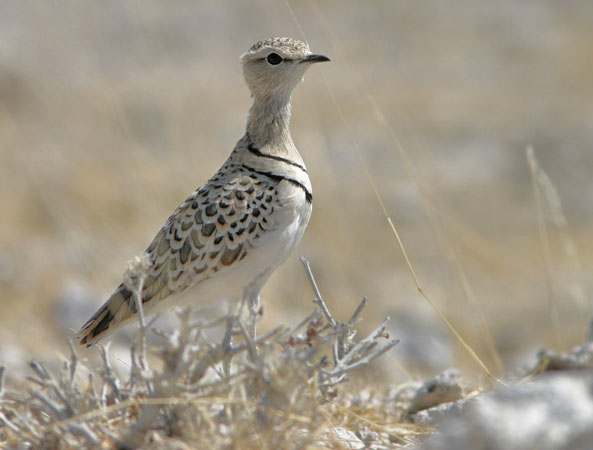 The Coursers and Pratincoles are a small family of shorebirds with slim, elongated bodies and (often) long wings. They are entirely restricted to the Old World. The coursers (8 species in the genera Rhinoptilus, Smutsornis, and Cursorius) are generally long-legged birds of short-grass plains or deserts, often far from water, like this Double-banded Courser in the arid deserts of Namibia (left). Yet one of my first, and memorable, encounters with a courser one at lake's edge: a Double-banded Courser (below) — the only member of genus Smutsornis — looking diminutive between large piles of hippo dung at Lake Jipe, West Tsavo NP, Kenya. The species has separate ranges in dry grasslands, open savanna, or arid deserts in east and southern Africa. The Coursers and Pratincoles are a small family of shorebirds with slim, elongated bodies and (often) long wings. They are entirely restricted to the Old World. The coursers (8 species in the genera Rhinoptilus, Smutsornis, and Cursorius) are generally long-legged birds of short-grass plains or deserts, often far from water, like this Double-banded Courser in the arid deserts of Namibia (left). Yet one of my first, and memorable, encounters with a courser one at lake's edge: a Double-banded Courser (below) — the only member of genus Smutsornis — looking diminutive between large piles of hippo dung at Lake Jipe, West Tsavo NP, Kenya. The species has separate ranges in dry grasslands, open savanna, or arid deserts in east and southern Africa.
The pratincoles— 7 species in the genus Glareola and 1 in Stiltia— are short-legged, water-edge birds, some preferring margins of lakes or estuaries. Another group is partial to the rocky shores and islets in rushing rivers, like Rock Pratincole (above). I've seen Rock Pratincoles in the Pra River in Ghana, the Ogooué River in Gabon, and the Victoria Nile below Murchison Falls in Uganda.
|
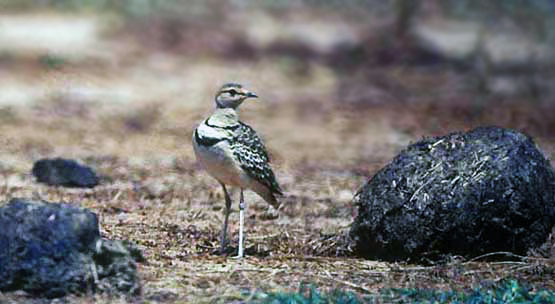 |
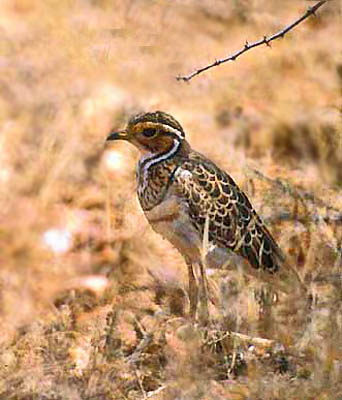 One of the most beautiful patterns belongs to Three-banded Courser of east Africa — often called Heuglin's Courser locally — one of three species in genus Rhinoptilus (right, this nice shot by Dale & Marian Zimmerman in Kenya). It seems to be largely nocturnal and hides in the shade of sparse bushes in its arid habitat during the day. I would never have seen this species on a 1981 Kenya trip but for a known stake-out that Terry Stevenson took us to see our only day with a guide. As with many things, there is no substitute for local knowledge One of the most beautiful patterns belongs to Three-banded Courser of east Africa — often called Heuglin's Courser locally — one of three species in genus Rhinoptilus (right, this nice shot by Dale & Marian Zimmerman in Kenya). It seems to be largely nocturnal and hides in the shade of sparse bushes in its arid habitat during the day. I would never have seen this species on a 1981 Kenya trip but for a known stake-out that Terry Stevenson took us to see our only day with a guide. As with many things, there is no substitute for local knowledge
All three Rhinoptilus coursers are nocturnal. They stand quietly in the shade during the day. The other African species is Bronze-winged Courser Rhinoptilus chalcopterus — a very widespread species throughout arid habitats south of the Sahara — but one that has entirely eluded me despite multiple efforts. It is said they are often killed on dirt roads at night that are in non-protected areas. Most African parks we have visited either ban or restrict night-driving.
The final species with in the genus is Jerdon's Courser Rhinoptilus bitorquatus of India. It was thought to be extinct until rediscovered in January 1986 after extensive surveys of habitat by the Bombay Natural History Society. It is one of the world's rarest birds and distinctly in danger of extinction. As Maclean (1996) summarized: "species rediscovered just in time, as planned irrigation scheme passing through [the only known] site was then diverted, following conservation pressure." Since then there has been progress in protecting its scrub desert habitat in Andhra Pradesh, east-central India, yet it is still considered critically endangered, with fewer than 250 adult birds.
All Rhinoptilus coursers have cryptic plumage that helps than hide in barren country, but they have striking and startling wing patterns in flight. Thus birds that can seem obvious during their rare flights may seem to "disappear" when they land.
Coursers and pratincoles have long been considered to be separate groups — in the past they have even by elevated to two families, or at least two subfamilies within the Glareolidae. However, molecular evidences suggests that Rhinoptilus coursers are sister to the rest of the family (Baker et al. 2007). Further, is was once thought that Egyptian Plover Pluvianus aegyptius and Crab-Plover Dromas ardeola were in the Glareolidae (e.g., Sibley & Monroe 1990). As to Egyptian Plover, an initial molecular analysis of 90 genera of shorebirds found that it was "apparently not a plover" (Baker et al. 2007). Fain & Houde (2007) reviewed mtDNA and nuclear DNA of 48 taxa, including some not previously studied, and determined that Egyptian Plover "is distinct for the Glareolidae" and found no evidence of any particular "special relationship with stone-curlews [thick-knees]" either. They suggested that it is a basal taxa among the Charadriiformes (like thick-knees) and that the evidence "is consistent with the previous proposals that it merits family status as Pluvianidae." Hackett et al. (2008), working with even a larger set of taxa, agreed, and also considered Crab-Plover to likely be a sister clade to Glareolidae. Thus Egyptian Plover and Crab-Plover are both now elevated to monotypic families.
|
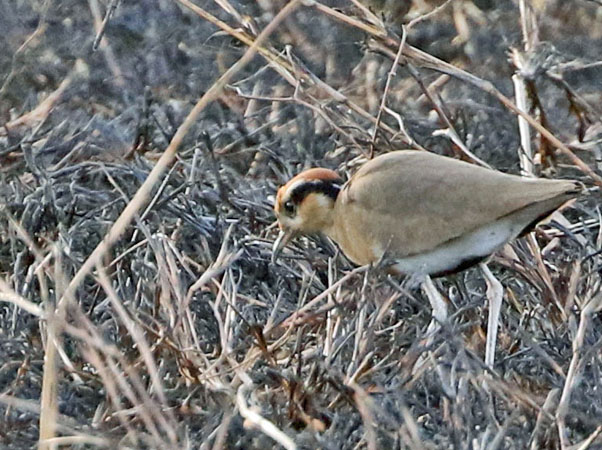 The five coursers in genus Cursorius are very much desert and arid-country species. Cream-colored Courser Cursorius cursor, which ranges from the Cape Verde and Canary Islands across north Africa to the Arabian Peninsula and the Middle East, is strongly associated with sandy deserts. The northern race is migratory — moving south as far as the Sahel south of the Sahara — has spun off vagrants as far north as the British Isles and Scandinavia. Indian Courser Cursorius coromandelicus is mostly a resident on the Indian subcontinent. The five coursers in genus Cursorius are very much desert and arid-country species. Cream-colored Courser Cursorius cursor, which ranges from the Cape Verde and Canary Islands across north Africa to the Arabian Peninsula and the Middle East, is strongly associated with sandy deserts. The northern race is migratory — moving south as far as the Sahel south of the Sahara — has spun off vagrants as far north as the British Isles and Scandinavia. Indian Courser Cursorius coromandelicus is mostly a resident on the Indian subcontinent.
The other three species in Cursorius are in sub-Saharan Africa, and most widespread is Temminck's Courser (left). It is often found in pairs or family groups, and is fond of short grassland, overgrazed areas, and is particularly partial to recently burned areas; numbers may appear within hours of the a recent fire. This one is actively foraging on a recently charred grassland in Mikumi NP, Tanzania.
All species among the Glareolidae feed primarily on insects. Pratincoles forage mostly in flight; coursers mostly on the ground.
|
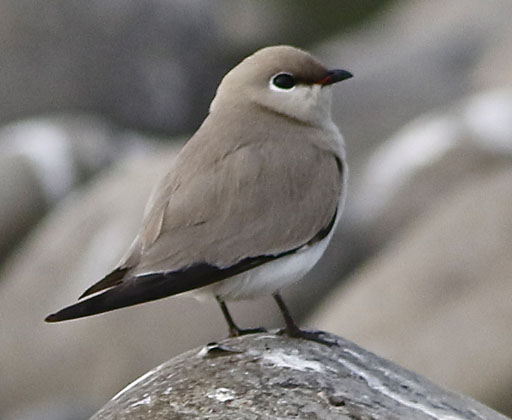 The Glareola pratincoles can be considered two sets of birds: three larger, extensively migratory species breeding in Eurasia, and four, mostly smaller, mostly resident tropical species generally confined to breeding along rocky or sandy shores of rivers. Rock Pratincole — photo at the top of this page — is a patchy resident of rocky shores and islets in fast-moving rivers throughout much of Africa. The habitat is similar for the mostly-resident Small Pratincole (right) of southern Asia (and the smallest pratincole). On various cold, rushing rivers in India, running down from the Himalayas, this species seems to frequent habitats that any dipper would enjoy. The Glareola pratincoles can be considered two sets of birds: three larger, extensively migratory species breeding in Eurasia, and four, mostly smaller, mostly resident tropical species generally confined to breeding along rocky or sandy shores of rivers. Rock Pratincole — photo at the top of this page — is a patchy resident of rocky shores and islets in fast-moving rivers throughout much of Africa. The habitat is similar for the mostly-resident Small Pratincole (right) of southern Asia (and the smallest pratincole). On various cold, rushing rivers in India, running down from the Himalayas, this species seems to frequent habitats that any dipper would enjoy.
Gray Pratincole Glareola cinerea is another small and quite lovely species, breeding on sand-bars in large, slow-moving rivers in central and west Africa. Much of the population moves short-distances with changes in water levels, and some winter along the coast. Likewise, the somewhat larger Madagascar Pratincole G. ocularis, which nests on rocky islets in permanent rivers and along coasts in Madagascar, migrates to coastal east Africa when not breeding.
Australian Pratincole (below), currently assigned to its own genus Stiltia but closely-related to Glareola, breeds mostly in Australia. It is a nomadic wanderer in the dry country of central and eastern Australia, moving with the rains and climate. Non-breeders disperse towards the coast or northwards to New Guinea (which has a couple of breeding records) and Indonesia. It is an exceptionally elegant, long-winged species. |
|
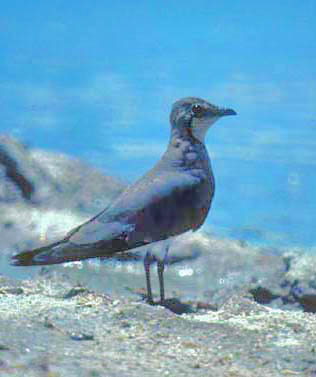 The three large species of Glareola pratincoles are highly migratory. The most widespread is Collared Pratincole (above and left), ranging from southern Europe and north Africa to Kazakhstan and Pakistan, with other resident populations in southern and east Africa. Populations from Eurasia winter in the Sahel of sub-Saharan Africa, typically north of 5° N, where they may overlap for a time with nomads from intra-African populations. The African populations are nomadic, appearing and disappearing suddenly, often in response to changing water levels (Maclean 1996). The three large species of Glareola pratincoles are highly migratory. The most widespread is Collared Pratincole (above and left), ranging from southern Europe and north Africa to Kazakhstan and Pakistan, with other resident populations in southern and east Africa. Populations from Eurasia winter in the Sahel of sub-Saharan Africa, typically north of 5° N, where they may overlap for a time with nomads from intra-African populations. The African populations are nomadic, appearing and disappearing suddenly, often in response to changing water levels (Maclean 1996).
Oriental Pratincole Glareola maldivarum and Black-winged Pratincole Glareola nordmanni are long-distance migrants. Black-winged breeds on steppe grasslands and the shores of inland seas in central Eurasia, and then migrates all the way to southern Africa (plus a few spots in west Africa). Oriental breeds from Siberia to southeast Asia, and patchily westwards to Sri Lanka and north India. It flies to Indonesia and Australasia in the non-breeding season.
The long distance of the migratory flights of these pratincoles has scattered vagrants across the Old World. Oriental Pratincole has reached the New World on Attu I. and St. Lawrence I., Alaska.
All three species have reached the Seychelles in the middle of the Indian Ocean. I even had the chance to photograph a Collared Pratincole (below) on the tiny, grassy airstrip of Fregaté Island in the Seychelles during autumn migration.
|
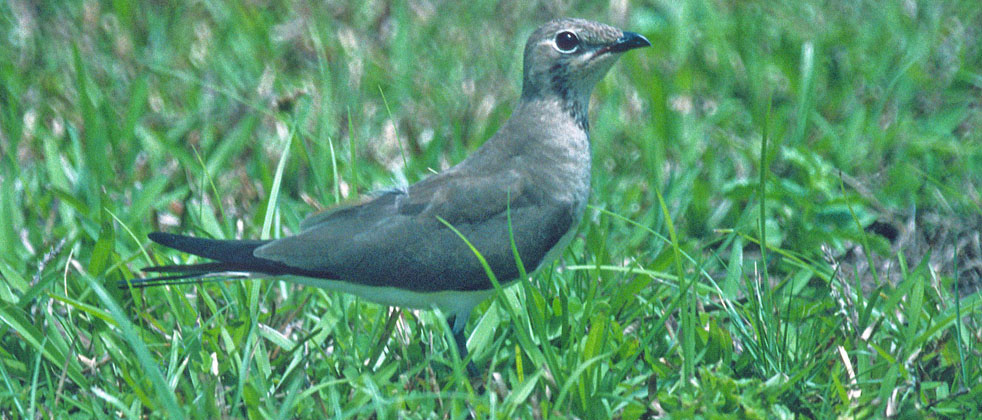 |
Which brings me to Kimball Garrett's wonderful bit of doggerel in his 1970's pastiche song, Birders' California — set to the tune and rhythm of the Eagles' hit Hotel California. The lines encapsulate the dreams of a California-based twitcher, listening to a Rare Bird Alert, as each bird mentioned is more provocative then the one before:
Come on up to Arcata, California ...
There's a Yellow Rail —
And a Scissor-tail . . .
Hurry on up to Bolinas, California,
There's an Ivory Gull —
And a pratincole !
|
No pratincole has reached California . . . yet. |
| |
Photos: The Rock Pratincole Glareola nuchalis was on the Pra River in Ghana on 3 Dec 2013. The two photos of Double-banded Courser Smutsornis africanus are from, respectively, Etosha NP, Namibia, on 20 July 2005, and along the shores of Lake Jipe, Kenya, on 26 Nov 1981. Dale & Marian Zimmerman photographed the Three-banded Courser Rhinoptilus cinctus in Samburu NP, Kenya, in 1981. The Temminck's Courser Cursorius temminckii was in Mikumi NP, Tanzania, on 11 July 2021. The Small Pratincole Glareola lactea was along the Kameng River, Assam, India, on 14 Mar 2019. The Australian Pratincole Stiltia isabella was at Goyder Lagoon, South Australia, on 20 Nov 2009. The three photos of Collared Pratincole Glareola pratincola were taken, respectively, at the Kilombero Swamp, Tanzania, on 8 July 2021 (flight shot); at the edge of Lake Jipe, West Tsavo NP, Kenya, on 26 Nov 1981; and on Fregaté Island, in the Seychelles, on 11 Nov 1992.
Rock Pratincole G. nuchalis
All photos © Don Roberson, except that attributed to Dale & Marian Zimmerman, and used with permission; all rights reserved.
Family Book: 
Hayman, Peter, John Marchant & Tony Prater. 1986. Shorebirds: An Identification Guide to the Waders of the World. Croom Helm, London.
[This review from 2001]: This book covers all the Charadriformes — not just the coursers and pratincoles — and so includes shorebirds (waders), stilts, avocets, jaçanas, thick-knees, plovers, and oystercatchers. It is not a "family book" per se, since its focus is on identification problems, but it does include sections on "habits" and migratory or seasonal "movements." Breeding biology and similar topics are not covered here. However, the quality of the identification text more than makes up for this deficiency, and adding broader topics would have made for a very fat book. John Marchant gets special credit for the text — an upgrade from his 1977 guide (with Prater & Vuorinen) — which surveyed the literature well and is based on much original research. The book does rely on Hayman's paintings for illustrations and while they are generally good, I think that photos are a necessary requirement when dealing with the subtleties of shorebird identification. So use this book as an introduction to these families — and the identification problems that exist — but rely on other texts for state-of-the-art details. Because Hayman et al. (1986) is really aimed at field identification issues, one should supplement it with the excellent introduction to this family in Maclean (1996), which also has an outstanding set of photographs. [Note: today (2021) there are many updated texts covering waders in general.]
Literature cited:
Baker, A.J., Pereira, S.L. & Paton, T.A. 2007. Phylogenetic relationships and divergence times of Charadriiformes genera: multigene evidence for the Cretaceous origin of at least 14 clades of shorebirds. Biology Letters 3: 205–209.
Fain, M.G., and P. Houde. 2004. Parallel radiations in the primary clades of birds. Evolution 58: 2558–2573.
Hackett, S.J., R.T. Kimball, S. Reddy, R.C.K. Bowie, E.L. Braun, M J. Braun, J.L. Chojnowski, W.A. Cox, K.-L. Han, J. Harshman, C.J. Huddleston, B.D. Marks, K.J. Miglia, W.S. Moore, F.H. Sheldon, D.W. Steadman, C C. Witt, and T. Yuri. 2008. A phylogenomic study of birds reveals their evolutionary history. Science 320: 1763–1768.
Maclean, G.L. 1996. Family Glareolidae (Coursers and Pratincoles), pp. 364–383 in Handbook of the Birds of the World (del Hoyo, J., A. Elliott & J. Sargatal, eds). Vol. 3. Lynx Edicions, Barcelona, Spain.
Sibley, C.G., and B.L. Monroe, Jr. 1990. Distribution and Taxonomy of Birds of the World. Yale Univ. Press, New Haven, CT.
|
|
|



 The five coursers in genus Cursorius are very much desert and arid-country species. Cream-colored Courser Cursorius cursor, which ranges from the Cape Verde and Canary Islands across north Africa to the Arabian Peninsula and the Middle East, is strongly associated with sandy deserts. The northern race is migratory — moving south as far as the Sahel south of the Sahara — has spun off vagrants as far north as the British Isles and Scandinavia. Indian Courser Cursorius coromandelicus is mostly a resident on the Indian subcontinent.
The five coursers in genus Cursorius are very much desert and arid-country species. Cream-colored Courser Cursorius cursor, which ranges from the Cape Verde and Canary Islands across north Africa to the Arabian Peninsula and the Middle East, is strongly associated with sandy deserts. The northern race is migratory — moving south as far as the Sahel south of the Sahara — has spun off vagrants as far north as the British Isles and Scandinavia. Indian Courser Cursorius coromandelicus is mostly a resident on the Indian subcontinent.  The Glareola pratincoles can be considered two sets of birds: three larger, extensively migratory species breeding in Eurasia, and four, mostly smaller, mostly resident tropical species generally confined to breeding along rocky or sandy shores of rivers. Rock Pratincole — photo at the top of this page — is a patchy resident of rocky shores and islets in fast-moving rivers throughout much of Africa. The habitat is similar for the mostly-resident Small Pratincole (right) of southern Asia (and the smallest pratincole). On various cold, rushing rivers in India, running down from the Himalayas, this species seems to frequent habitats that any dipper would enjoy.
The Glareola pratincoles can be considered two sets of birds: three larger, extensively migratory species breeding in Eurasia, and four, mostly smaller, mostly resident tropical species generally confined to breeding along rocky or sandy shores of rivers. Rock Pratincole — photo at the top of this page — is a patchy resident of rocky shores and islets in fast-moving rivers throughout much of Africa. The habitat is similar for the mostly-resident Small Pratincole (right) of southern Asia (and the smallest pratincole). On various cold, rushing rivers in India, running down from the Himalayas, this species seems to frequent habitats that any dipper would enjoy. 
 The Coursers and Pratincoles are a small family of shorebirds with slim, elongated bodies and (often) long wings. They are entirely restricted to the Old World. The coursers (8 species in the genera Rhinoptilus, Smutsornis, and Cursorius) are generally long-legged birds of short-grass plains or deserts, often far from water, like this Double-banded Courser in the arid deserts of Namibia (left). Yet one of my first, and memorable, encounters with a courser one at lake's edge: a Double-banded Courser (below) — the only member of genus Smutsornis — looking diminutive between large piles of hippo dung at Lake Jipe, West Tsavo NP, Kenya. The species has separate ranges in dry grasslands, open savanna, or arid deserts in east and southern Africa.
The Coursers and Pratincoles are a small family of shorebirds with slim, elongated bodies and (often) long wings. They are entirely restricted to the Old World. The coursers (8 species in the genera Rhinoptilus, Smutsornis, and Cursorius) are generally long-legged birds of short-grass plains or deserts, often far from water, like this Double-banded Courser in the arid deserts of Namibia (left). Yet one of my first, and memorable, encounters with a courser one at lake's edge: a Double-banded Courser (below) — the only member of genus Smutsornis — looking diminutive between large piles of hippo dung at Lake Jipe, West Tsavo NP, Kenya. The species has separate ranges in dry grasslands, open savanna, or arid deserts in east and southern Africa. One of the most beautiful patterns belongs to Three-banded Courser of east Africa — often called Heuglin's Courser locally — one of three species in genus Rhinoptilus (right, this nice shot by Dale & Marian Zimmerman in Kenya). It seems to be largely nocturnal and hides in the shade of sparse bushes in its arid habitat during the day. I would never have seen this species on a 1981 Kenya trip but for a known stake-out that Terry Stevenson took us to see our only day with a guide. As with many things, there is no substitute for local knowledge
One of the most beautiful patterns belongs to Three-banded Courser of east Africa — often called Heuglin's Courser locally — one of three species in genus Rhinoptilus (right, this nice shot by Dale & Marian Zimmerman in Kenya). It seems to be largely nocturnal and hides in the shade of sparse bushes in its arid habitat during the day. I would never have seen this species on a 1981 Kenya trip but for a known stake-out that Terry Stevenson took us to see our only day with a guide. As with many things, there is no substitute for local knowledge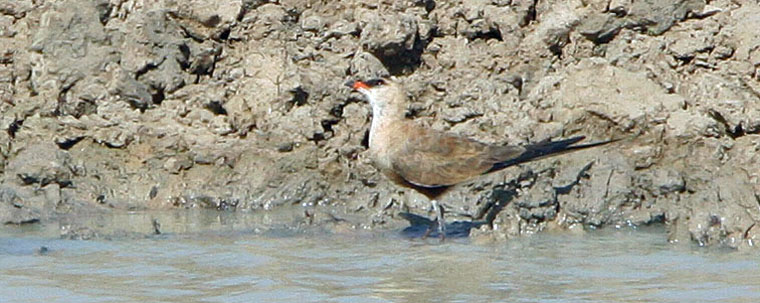
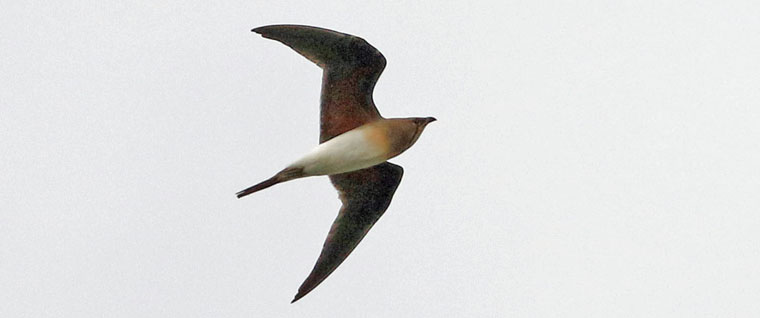
 The three large species of Glareola pratincoles are highly migratory. The most widespread is Collared Pratincole (above and left), ranging from southern Europe and north Africa to Kazakhstan and Pakistan, with other resident populations in southern and east Africa. Populations from Eurasia winter in the Sahel of sub-Saharan Africa, typically north of 5° N, where they may overlap for a time with nomads from intra-African populations. The African populations are nomadic, appearing and disappearing suddenly, often in response to changing water levels (Maclean 1996).
The three large species of Glareola pratincoles are highly migratory. The most widespread is Collared Pratincole (above and left), ranging from southern Europe and north Africa to Kazakhstan and Pakistan, with other resident populations in southern and east Africa. Populations from Eurasia winter in the Sahel of sub-Saharan Africa, typically north of 5° N, where they may overlap for a time with nomads from intra-African populations. The African populations are nomadic, appearing and disappearing suddenly, often in response to changing water levels (Maclean 1996).